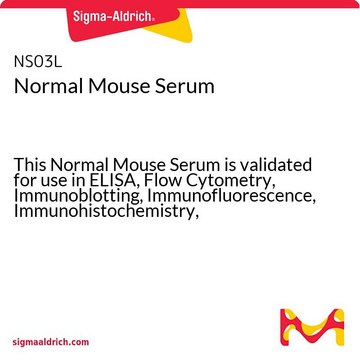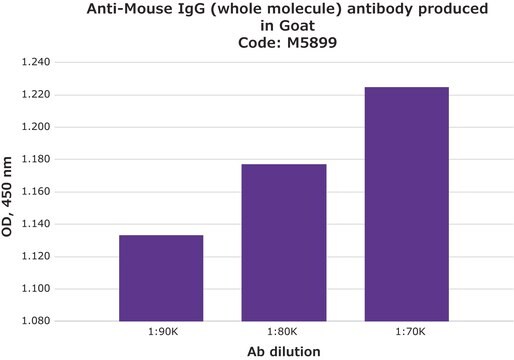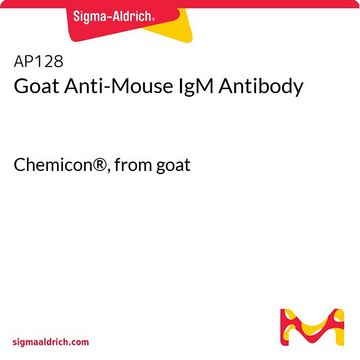M5774
Anti-Mouse Serum antibody produced in rabbit
whole antiserum
Se connecterpour consulter vos tarifs contractuels et ceux de votre entreprise/organisme
About This Item
Produits recommandés
Source biologique
rabbit
Conjugué
unconjugated
Forme d'anticorps
whole antiserum
Type de produit anticorps
primary antibodies
Clone
polyclonal
Contient
15 mM sodium azide
Espèces réactives
mouse
Technique(s)
immunoelectrophoresis: suitable
Conditions d'expédition
dry ice
Température de stockage
−20°C
Modification post-traductionnelle de la cible
unmodified
Description générale
Mouse serum comprises hormones, antigens, electrolytes and antibodies. It serves blocking agent in immunoassays.
Spécificité
Strong reactivity with normal mouse serum has been determined by immunoelectrophoresis (IEP). This antiserum has not been assayed for interspecies crossreactivity.
Application
Anti-Mouse Serum antibody produced in rabbit has been used in differential fluorescent labelling. It has also been used in differential staining of inner cell mass (ICM) and and trophectoderm (TE) cells. It has been also been used in the removal of zona pellucidae for the isolation of inner cell mass (ICM) from mouse blastocysts.
Anti-Mouse Serum antibody produced in rabbit was used as blocking agent in differential cell count of trophectoderm and inner cell mass cells of mouse embryos.
Forme physique
Rabbit Anti-Mouse Serum is provided as a liquid containing 15 mM sodium azide as preservative.
Stockage et stabilité
For continuous use, store at 2-8 °C for up to one month. For extended storage, the solution may be frozen in working aliquots. Repeated freezing and thawing is not recommended. Storage in "frost-free" freezers not recommended. If slight turbidity occurs upon prolonged storage, clarify the solution by centrifugation before use.
Clause de non-responsabilité
Unless otherwise stated in our catalog or other company documentation accompanying the product(s), our products are intended for research use only and are not to be used for any other purpose, which includes but is not limited to, unauthorized commercial uses, in vitro diagnostic uses, ex vivo or in vivo therapeutic uses or any type of consumption or application to humans or animals.
Vous ne trouvez pas le bon produit ?
Essayez notre Outil de sélection de produits.
Code de la classe de stockage
10 - Combustible liquids
Classe de danger pour l'eau (WGK)
WGK 3
Point d'éclair (°F)
Not applicable
Point d'éclair (°C)
Not applicable
Faites votre choix parmi les versions les plus récentes :
Déjà en possession de ce produit ?
Retrouvez la documentation relative aux produits que vous avez récemment achetés dans la Bibliothèque de documents.
Effects of paternal heat stress on the in vivo development of preimplantation embryos in the mouse
Zhu BK and Setchell BP
Reproduction, Nutrition, Development, 44(6), 617-629 (2004)
U Sanmee et al.
Theriogenology, 75(9), 1682-1687 (2011-03-02)
We studied the co-culturing effect of intact and half-destroyed 4-cell mouse embryos on blastocyst formation rate and cell counts. A laser beam was used to produce a hole and destroy an adjacent blastomere in two opposite areas of the zona
Namfon Inna et al.
Clinical and experimental reproductive medicine, 45(3), 110-115 (2018-09-12)
To compare our in-house method of embryo freezing with Cryotop vitrification in terms of immediate survival, subsequent cleavage and blastocyst formation, and cell numbers in blastocysts. Two-cell mouse embryos were randomly allocated into three groups: a non-frozen control group (group
Both the folate cycle and betaine-homocysteine methyltransferase contribute methyl groups for DNA methylation in mouse blastocysts
Zhang B, et al.
Faseb Journal, 29(3), 1069-1079 (2015)
Bi-ke Zhu et al.
Reproduction, nutrition, development, 44(3), 219-231 (2004-10-06)
This study was undertaken to investigate the effects of three media, volume and type of oil and frequency of observation on the in vitro development of mouse zygotes. B6CBF1 female mice (4 to 6 wk old) were superovulated using PMSG/hCG
Notre équipe de scientifiques dispose d'une expérience dans tous les secteurs de la recherche, notamment en sciences de la vie, science des matériaux, synthèse chimique, chromatographie, analyse et dans de nombreux autres domaines..
Contacter notre Service technique








